
eBook - ePub
Kilroy Was There
A GI's War in Photographs
Tony Hillerman
This is a test
Compartir libro
- 80 páginas
- English
- ePUB (apto para móviles)
- Disponible en iOS y Android
eBook - ePub
Kilroy Was There
A GI's War in Photographs
Tony Hillerman
Detalles del libro
Vista previa del libro
Índice
Citas
Información del libro
When I saw Frank Kessler's collection of photographs I was struck by how different they were from the movie-camera views I see on television. No public relations pictures here, intended to glorify battle and rally support. These were up-close snapshots of the dirty, damp, and disheveled men in the rifle companies and tank units. It was the war as they endured it, as they struggled through it from the beaches of France to the streets of Berlin until they finally won it. —Tony Hillerman
Preguntas frecuentes
¿Cómo cancelo mi suscripción?
¿Cómo descargo los libros?
Por el momento, todos nuestros libros ePub adaptables a dispositivos móviles se pueden descargar a través de la aplicación. La mayor parte de nuestros PDF también se puede descargar y ya estamos trabajando para que el resto también sea descargable. Obtén más información aquí.
¿En qué se diferencian los planes de precios?
Ambos planes te permiten acceder por completo a la biblioteca y a todas las funciones de Perlego. Las únicas diferencias son el precio y el período de suscripción: con el plan anual ahorrarás en torno a un 30 % en comparación con 12 meses de un plan mensual.
¿Qué es Perlego?
Somos un servicio de suscripción de libros de texto en línea que te permite acceder a toda una biblioteca en línea por menos de lo que cuesta un libro al mes. Con más de un millón de libros sobre más de 1000 categorías, ¡tenemos todo lo que necesitas! Obtén más información aquí.
¿Perlego ofrece la función de texto a voz?
Busca el símbolo de lectura en voz alta en tu próximo libro para ver si puedes escucharlo. La herramienta de lectura en voz alta lee el texto en voz alta por ti, resaltando el texto a medida que se lee. Puedes pausarla, acelerarla y ralentizarla. Obtén más información aquí.
¿Es Kilroy Was There un PDF/ePUB en línea?
Sí, puedes acceder a Kilroy Was There de Tony Hillerman en formato PDF o ePUB, así como a otros libros populares de History y World War II. Tenemos más de un millón de libros disponibles en nuestro catálogo para que explores.
Información
Categoría
HistoryCategoría
World War IIWe gray and grizzled veterans sometimes call it “the last good war,” and, indeed, it did offer Kilroys some moments of pride, captured so well by Kessler and others in Normandy street scenes where jubilant residents thank their liberators, children gather around a truck to get chewing gum, and GIs pause a moment to accept a gift of wine in their canteen cups and in pictures of refugee families returning to their ravaged but liberated homes.
But most of us Kilroys missed these joyful celebrations. Villagers wisely took shelter elsewhere when war came down their streets, and duty kept front echelon soldiers moving.
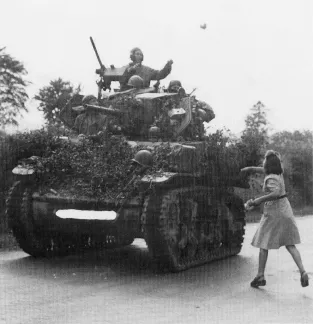
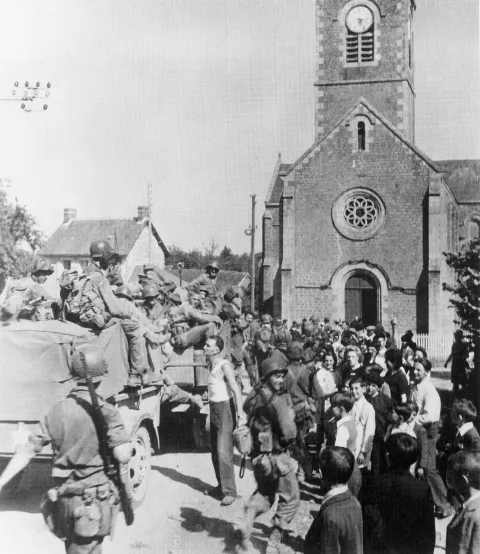
Villagers greet U.S. troops. Summer 1944, northern France
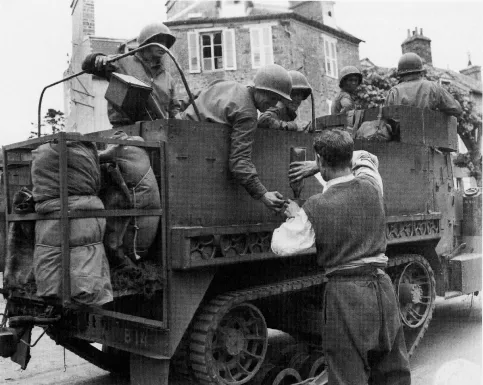
Residents of northern French villages welcome U.S. troops and return to their homes, June–September 1944.
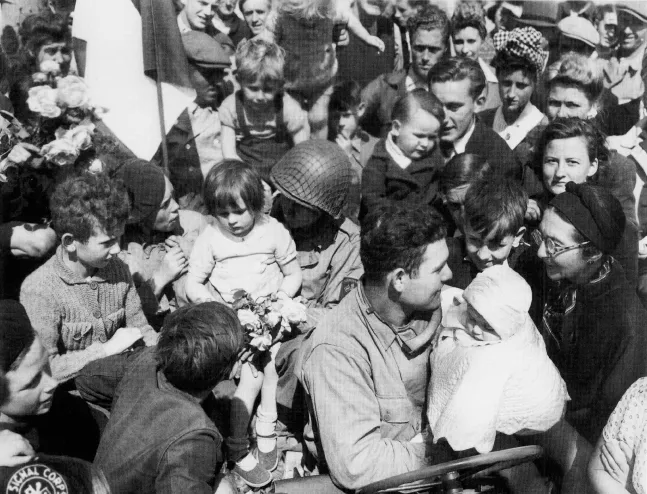
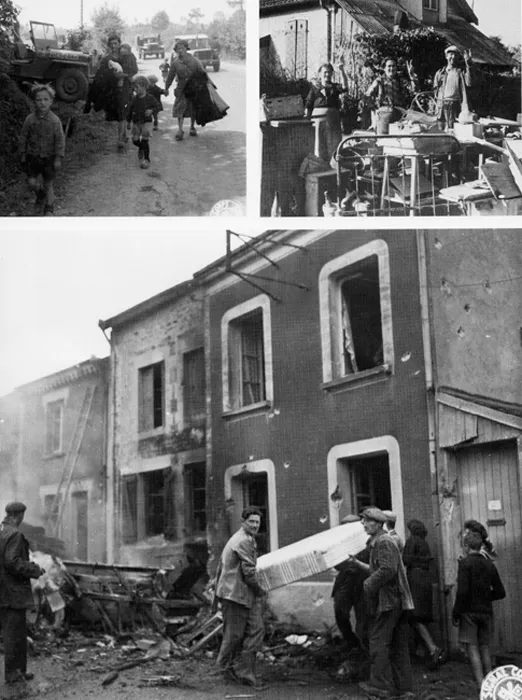

Parisians celebrate their city’s liberation and liberators, August 1944
In the biggest liberation celebration, U.S. Army combat units were held back at the fringes of Paris to allow Charles de Gaulle and his Free French Army the glory of their nation’s salvation. That was okay with us. Rifle squad members by then had done enough street and hedgerow fighting to gladly leave most of the rooting out of German snipers and capture of German prisoners to the home boys. (Besides, being around the generals and the crowd of colonels required getting boots cleaned and “looking like a soldier.”)


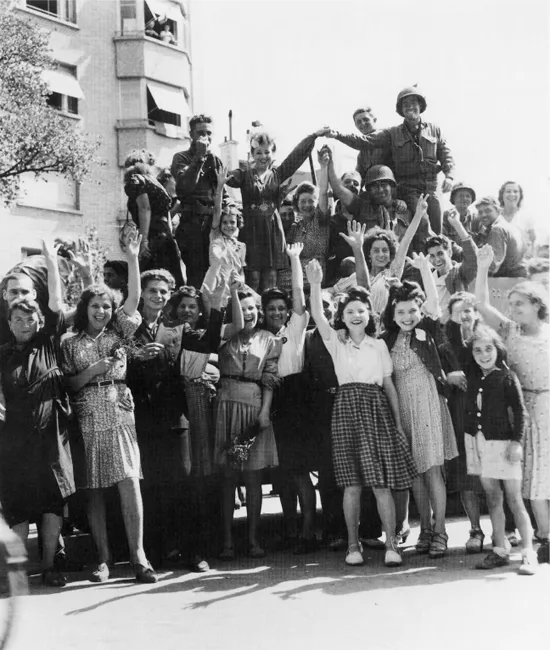


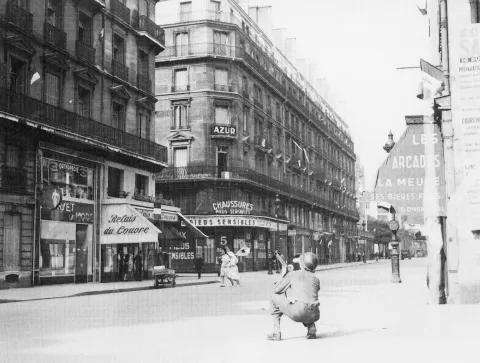
German air power and snipers still posed a threat to Free French and U.S. forces. August 1944, Paris
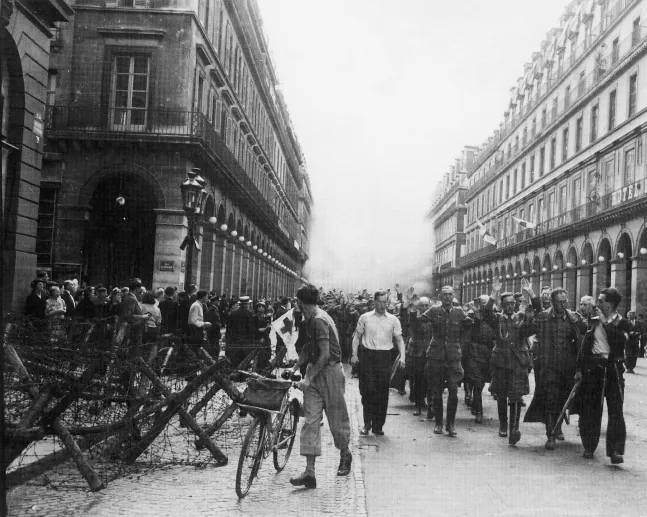
Hands up, a German garrison surrenders. August 1944, Paris
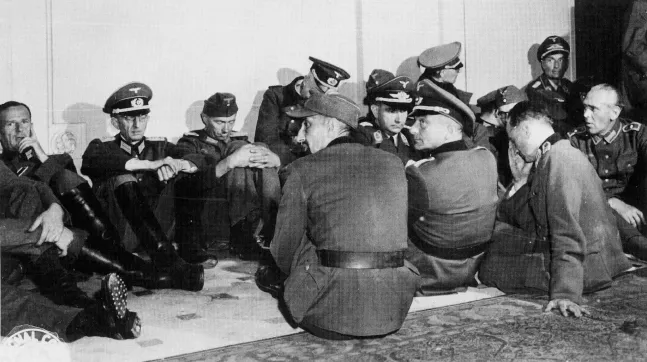
High-ranking German officers await processing in the Hotel Majestic, where they had established headquarters during their occupation. August 1944, Paris
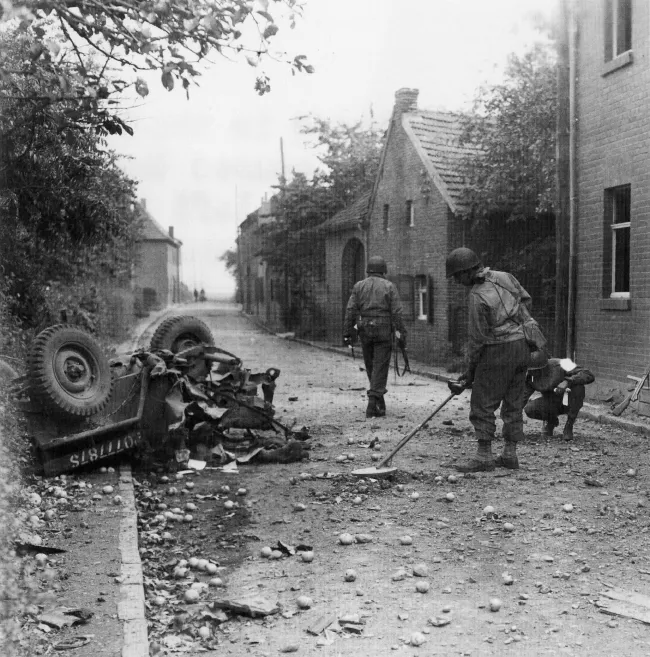
GIs search for more buried mines like the one that blew up this jeep, killing three of their own. October 1944, Germany
Alas, those few joyful memories were offset by the countless grim ones. And one that is difficult for even long-ago soldiers to erase is our first up-close-and-personal encounter with death—no matter the side. The German sprawled on the sidewalk (opposite) still holds the grenade he was poised to throw when the fatal bullet struck him. He would have killed you if he could have, but 60 years later you still remember that he looked a lot like you. Even more indelible are farewells to your own. This Kilroy (opposite), head wound bandaged, is about to be ambulanced back to his battalion’s aid station. If he lives, you may see him again, brought back on a replacement truck to fight some more. Or this may be, if he’s lucky, the “million-dollar wound” that sends him home alive. But the man lying face down (below) is a subject for the Grave Registration team, as is the soldier whose body has been covered with flowers by the French citizens looking on.
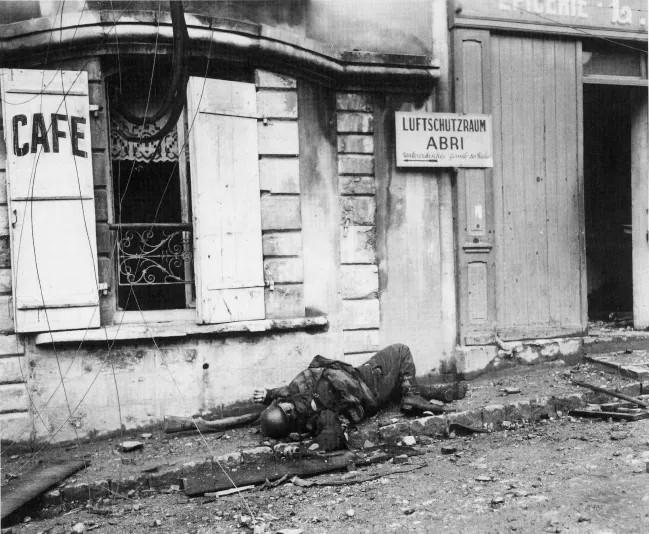

Casualties of war. June 1944, near Cherbourg, France
Medics earned an almost awed respect from their fellow Kilroys. The medics treating the wounded or leading the injured to safety were exactly as vulnerable as the soldiers whose lives they were trying to save. Of the aid men who came for me when I got my million-dollar wound, two were wounded, one fatally.
Injury was not the only relief from combat. The Army did develop rotation systems. For air corpsmen a certain number of combat missions would send them home to train other flight crews. For the infantrymen points were tallied based on months in combat plus extra points (for example, five for a combat wound and five for a “beyond the call of duty” decoration), and there was also a rotation system under which a company could send men back to Paris for a week of R&R, rest and relaxation. Unfortunately, the average infantryman lasted slightly less than six months in combat, winning either a Z-class (Zone of Interior) wound or a body bag before any rotation relief. At the time I was wounded and out of the war, on February 27, 1945, only five men in my Charley Company had yet lasted long enough to benefit from the point rotation system.

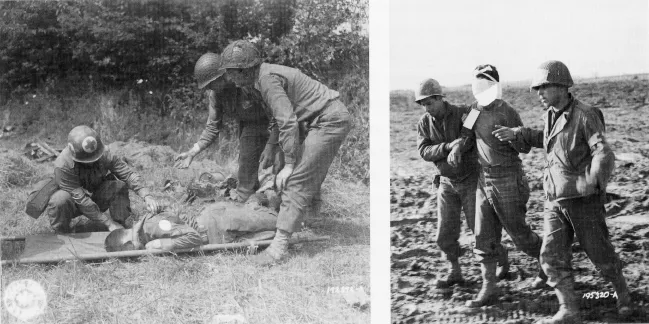
Medics attend to the injured on the front lines: (above)August 1944, France; (below)September 1944, Belgium.
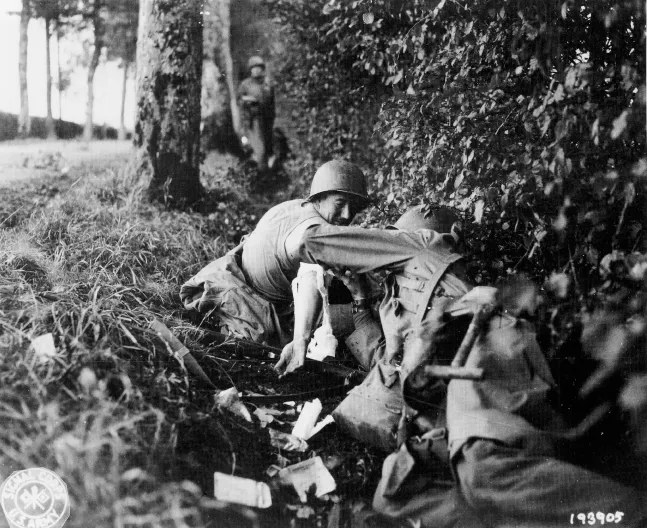
The observation that “war is long days of boredom punctuated by exhilarating moments of fear” is only somewhat exaggerated. For the Kilroys, there was everyday life to be lived, or survived. Some of Kessler’s boys’ most intimate portraits were of us Kilroys going about the mundane.
Illustrated in a photo of troops attending mass is the adage that there are no atheists in foxholes, that at least some of us were believers. (In my own experience, I saw only four chaplains. One was driving through a shattered French village when we flagged him down and asked him to perform services for us in the local church. A second was in a medical clearing station at Saverne. The third we happened on in a snowy Vosges Mountain field. And the fourth I met in the Third General Hospital at Aix en Provence, where I was awaiting a hospital ship to haul me home.)
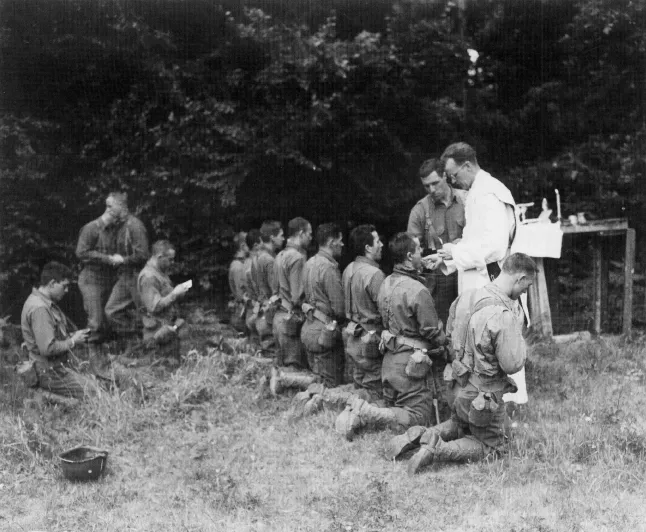
July 1944, France
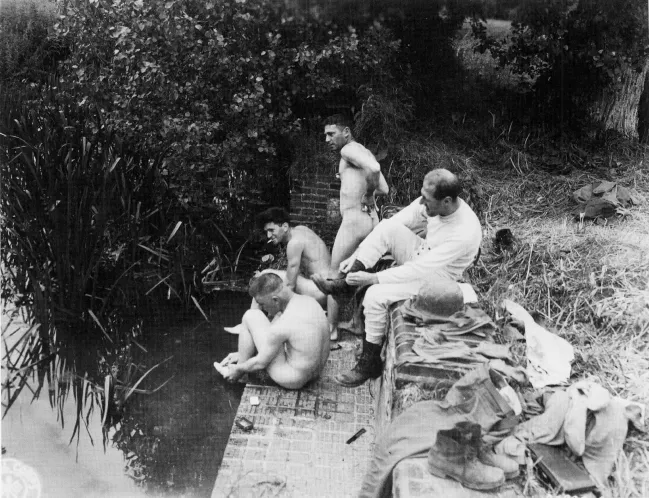
The notion of “cleanliness is next to godliness” did not hold true for combat troops. We washed up where we could—be it a murky stream or a village pump. My Charley Company had only one Army-provided bath from the time we entered combat in September 1944 until March 1945. With the company in Division Reserve, we were treated to a hot shower. In two huge tents erected in a snowy field, we stripped and marched naked (but clutching our boots) into the shower tent, where a gasoline burner heated the water. We scrubbed furiously at the embedded grime with bar soap before rinsing off. We picked up clean socks, shorts, and long johns from a table and reclaimed our dirty uniforms. Beneath the dirty clothes we were clean again—a wonderful feeling!

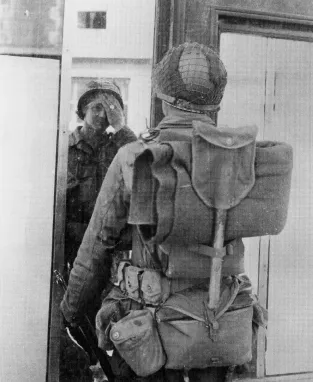
Kilroys were astonished to see themselves in mirrors after life in and out of foxholes. August 1944, France
But it was food, or the lack of it, that consumed most of our thoughts. We were hungry. After all, most of us Kilroys were still in our growing years. We survived mostly on canned C-rations or, even worse, boxed K-rations. Can and box contents varied. Kessler and his men caught us eating what and where ...